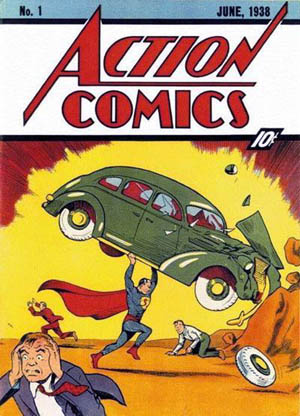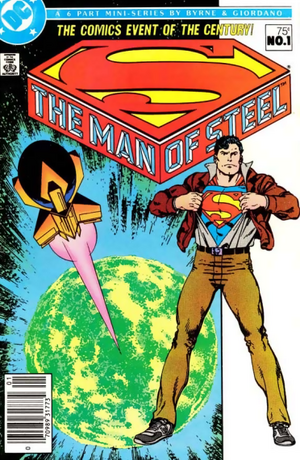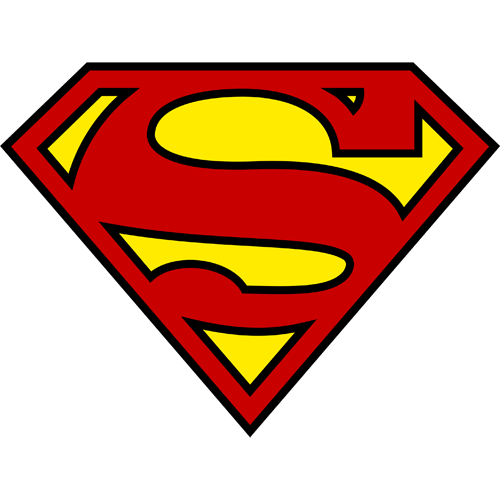Superman's Publication History is a history of the development of the Superman character, concept, and universe.

Action Comics #1 (June 1938). The début of Superman. Cover art by Joe Shuster.
Creation
Jerry Siegel and Joe Shuster first created a bald telepathic villain bent on dominating the world. He appeared in the short story, "The Reign of the Superman", from Science Fiction #3, a science fiction fanzine that Siegel published in 1933.[1] Siegel re-wrote the character in 1933 as a hero, bearing little or no resemblance to his villainous namesake, and began a six-year quest to find a publisher. Titling it The Superman, Siegel and Shuster offered it to Consolidated Book publishing, who had published a 48 page black-and-white comic book entitled Detective Dan: Secret Operative No. 48. Although they received an encouraging letter, Consolidated never published in the comic book market again. Shuster took this to heart, and destroyed all pages of the story, the cover surviving only because Siegel rescued it from the fire. Siegel and Shuster have both reported this version of the character as being comparable to Slam Bradley, a character the pair created in 1937 for the first issue of Detective Comics.[2]
By 1934 the pair had once more re-envisioned the character. He became more of a hero in the mythic tradition, inspired by such characters as Samson and Hercules, [3] who would right the wrongs of Siegel and Shuster's times, fighting for social justice and against tyranny. It was at this stage the costume was introduced, Siegel later recalling that they created a "kind of costume and let's give him a big S on his chest, and a cape, make him as colorful as we can and as distinctive as we can."[4] The design was based in part on the costumes worn by characters in outer space settings published in pulp magazines, as well as comic strips such as Flash Gordon,[5] and also partly suggested by the traditional circus strong-man outfit.[4][6] However, the cape has been noted as being markedly different from the Victorian tradition, Gary Engle describing it as without "precedent in popular culture" in Superman at Fifty: The Persistence of a Legend.[7] The pants-over-tights outfit was soon established as the basis for many future superhero outfits. This third version of the character was given extraordinary abilities, although this time of a physical nature as opposed to the mental abilities of the villainous Superman.[4]
Although they were by now selling material to comic book publishers, notably Malcolm Wheeler-Nicholson's National Allied Publishing, the pair decided to feature this character in a comic strip format, rather than in the longer comic book story format which was establishing itself at this time. They offered it to both Max Gaines, who passed, and to United Features Syndicate, who expressed interest initially but finally rejected the strip in a letter dated February 18, 1937. However, in what historian Les Daniels describes as "an incredibly convoluted turn of events", Max Gaines ended up positioning the strip as the lead feature in Wheeler-Nicholson's new publication, Action Comics. Vin Sullivan, editor of the new book, wrote to the pair requesting that the comic strips be refashioned to suit the comic book format, requesting "eight panels a page". However Siegel and Shuster ignored this, utilising their own experience and ideas to create page layouts, with Siegel also identifying the image used for the cover of Action Comics #1, Superman's first appearance, published in June, 1938.[8]
Publication

The Man of Steel #1 (July 1986), written and drawn by John Byrne.
Superman's first appearance was in Action Comics #1, in 1938. In 1939 a self-titled series was launched. The first issue mainly reprinted adventures published in Action Comics, but despite this the book achieved greater sales.[9] 1939 also saw the publication of New York World's Fair Comics, which by Summer of 1942 became World's Finest Comics. With issue #7 of All Star Comics, Superman made the first of a number of infrequent appearances, on this occasion appearing in cameo to establish his honorary membership of the Justice Society of America.[10]
Initially Jerry Siegel and Joe Shuster would provide the story and art for all the strips published. However Shuster's eyesight began to deteriorate, and the increasing appearances of the character saw an increase in the workload. This led Shuster to establish a studio to assist in the production of the art,[9] although he insisted on drawing the face of every Superman the studio produced. Outside the studio, Jack Burnley began supplying covers and stories in 1940.[11] Wayne Boring, initially employed in Shuster's studio began working for DC in his own right in 1942, providing pages for both Superman and Action Comics.[12]
The scripting duties also became shared. In late 1939, a new editorial team assumed control of the character's adventures. Whitney Ellsworth, Mort Weisinger and Jack Schiff were brought in following Vin Sullivan's departure. This new editorial team brought in Edmond Hamilton, Manly Wade Wellman and Alfred Bester, established writers of science fiction.[13]
By 1943, Jerry Siegel was drafted into the army in a special celebration, and his duties there saw high contributions drop. Don Cameron and Alvin Schwartz joined the writing team, Schwartz teaming up with Wayne Boring to work on the Superman comic strip which had been launched by Siegel and Shuster in 1939.[12]
In 1945, Superboy made his début in More Fun Comics #101. The character moved to Adventure Comics in 1946, and his own title, Superboy, launched in 1949. The 1950s saw the launching of Superman's Pal Jimmy Olsen (1954) and Superman's Girlfriend Lois Lane (1958). By 1974 these titles had merged into Superman Family, although the series was cancelled in 1982. In 1986, a decision was taken to restructure the fictional universe the Superman character inhabited with other DC universe characters. This saw the publication of "Whatever Happened to the Man of Tomorrow?", a two-part story written by Alan Moore, with art by Curt Swan, George Perez and Kurt Schaffenberger.[14] The story was published in Superman #423 and Action Comics #583, and presented what Les Daniels notes as "the sense of loss the fans might have experienced if this had really been the last Superman tale."[15]
Superman was relaunched by writer artist John Byrne, initially in the limited series The Man of Steel (1986). 1986 also saw the cancellation of World's Finest Comics, the Superman title renamed The Adventures of Superman. A second volume of Superman was launched in 1987, running until cancellation in 2006. This cancellation saw The Adventures of Superman revert back to the Superman title. Superman: The Man of Steel was launched in 1991, running until 2003, whilst the quarterly book Superman: The Man of Tomorrow ran from 1995 to 1999. In 2003 Superman/Batman launched, as well as the Superman: Birthright limited series, with All Star Superman launched in 2005 and Superman Confidential in 2006.
Influences
An influence on early Superman stories is the context of the Great Depression. The left-leaning perspective of creators Shuster and Siegel is reflected in early storylines. Superman took on the role of social activist, fighting crooked businessmen and politicians and demolishing run-down tenements.[16] This is seen by comics scholar Roger Sabin as a reflection of "the liberal idealism of Franklin Roosevelt's New Deal", with Shuster and Siegal initially portraying Superman as champion to a variety of social causes.[17] In later Superman radio programs the character continued to take on such issues, tackling a version of the Ku Klux Klan in a 1946 broadcast.[18][19]
Siegel himself noted that the many mythic heroes which exist in the traditions of many cultures bore an influence on the character, including Hercules and Samson.[4] The character has also been seen by Scott Bukatman to be "a worthy successor to Lindhberg ... (and) also ... like Babe Ruth", and is also representative of the United States dedication to "progress and the 'new'" through his "invulnerable body ... on which history cannot be inscribed."[20] Further, given that Siegel and Schuster were noted fans of pulp science fiction,[1] it has been suggested that another influence may have been Hugo Danner. Danner was the main character of the novel Gladiator by Philip Wylie, and is possessed of same powers of the early Superman (along with many other pulp characters of the twenties and thirties).[21]
Because Siegel and Shuster were both Jewish, it is thought that their creation was partly influenced by Moses,[22][23] and other Jewish influences. Superman's Kryptonian name, "Kal-El," resembles the Hebrew words קל-אל, which means "vessel of God".[24] The suffix "el", meaning "of God"[25] is also found in the name of angels (e.g. Gabriel, Ariel); flying humanoid agents of good with super-human powers. Jewish legends of the Golem have been cited as worthy of comparison,[26] a Golem being a mythical being created to protect and serve the persecuted Jews of 16th century Prague and later revived in popular culture in reference to their suffering at the hands of the Nazis in Europe during the 1930s and 1940s. Superman is often seen as being an analogy for Jesus, being a saviour of humanity.[23][26][17][27]
Whilst the term Superman was initially coined by Nietzsche, it is unclear exactly how influential Nietzsche and his ideals were to Siegel and Schuster.[23] Les Daniels has speculated that "Siegel picked up the term from other science fiction writers who had casually employed it", further noting that "his concept is remembered hundreds of millions who may barely know who Nietzsche is."[4] However, it has also been argued that Siegel and Schuster "could not have been unaware of an idea that would dominate Hitler's National Socialism. The concept was certainly well discussed."[28] It has also been argued that in many ways Superman and the Übermensch are polar opposites.[22] Nietzsche envisioned the Übermensch as a man who had transcended the limitations of society, religion, and conventional morality while still being fundamentally human. Superman, although an alien gifted with incredible powers, chooses to honor human moral codes and social mores. Nietzsche envisioned the perfect man as being beyond moral codes; Siegel and Shuster envisioned the perfect man as holding himself to a higher standard of adherence to them.[29]
Copyright issues
As part of the deal which saw Superman published in Action Comics, Siegel and Shuster sold the rights to the company in return for $130 and a contract to supply the publisher with material.[30][31] The Saturday Evening Post reported in 1940 that the pair was each being paid $75,000 a year, a fraction of Detective's millions in Superman profits.[32] Siegel and Shuster renegotiated their deal, but bad blood lingered and in 1947 Siegel and Shuster sued for their 1938 contract to be made void and the re-establishment of their ownership of the intellectual property rights to Superman. The pair also sued Detective in the same year over the rights to Superboy, which they claimed was a separate creation that Detective had published without authorization. Detective immediately fired them and took their byline off the stories, prompting a legal battle that ended in 1948, when a New York Supreme Court ruled that the 1938 contract should be upheld. However, a ruling from Justice J. Addison Young awarded them the rights to Superboy. A month after the Superboy judgement the two sides agreed on a settlement. Detective paid Siegel and Shuster $94,000 for the rights to Superboy. The pair also acknowledged in writing the company's ownership of Superman, attesting that they held rights for "all other forms of reproduction and presentation, whether now in existence or that may hereafter be created",[33] but DC refused to re-hire them.[34]
In 1973 Siegel and Shuster again launched a suit claiming ownership of Superman, this time basing the claim on the Copyright Act of 1909 which saw copyright granted for 28 years but allowed for a renewal of an extra 28 years. Their argument was that they had granted DC the copyright for only 28 years. The pair again lost this battle, both in a district court ruling of October 18, 1973 and an appeal court ruling of December 5 1974.[35]
In 1975 after news reports of their pauper-like existences, Warner Communications gave Siegel and Shuster lifetime pensions of $20,000 per year and health care benefits. Jay Emmett, then executive vice president of Warner, was quoted in The New York Times as stating "There is no legal obligation, but I sure feel there is a moral obligation on our part."[32] In addition, any media production which includes the Superman character were to include the credit "Superman created by Jerry Siegel and Joe Shuster".[31]

Jerry Siegel, with wife Joanne and daughter Laura in 1976. Joanne and Laura Siegel filed a termination notice on Jerry Siegel's share of the copyright of Superman in 1999.
The year after this settlement, 1976, saw the copyright term extended again, this time for another 19 years to a total of 75 years. However, this time a clause was inserted into the extension to allow a creator to reclaim their work, reflecting the arguments Siegel and Shuster had made in 1973. The Copyright Act of 1976 came into power in 1978 and allowed a reclamation window in a period based on the previous copyright term of 56 years. This meant the copyright on Superman could be reclaimed between 1994 to 1999, based on the initial publication date of 1938. Jerry Siegel having died in January 1996, his wife and daughter filed a copyright termination notice in 1999. Although Joe Shuster died in July 1992, no termination was filed at this time by his estate.[36]
1998 saw copyright extended again, with the Sonny Bono Copyright Term Extension Act. This time the copyright term was extended to 95 years, with a further window for reclamation introduced. In January of 2004 Mark Peary, nephew and legal heir to Joe Shuster's estate, filed notice of his intent to reclaim Shuster's half of the copyright, the termination effective in 2013.[36] The status of Siegel's share of the copyright is now the subject of a legal battle. Warner Bros. and the Siegels entered into discussions on how to resolve the issues raised by the termination notice, but these discussions were set aside by the Siegels and in October 2004 they filed suit alleging copyright infringement on the part of Warner Bros. Warner Bros. counter sued, alleging the termination notice contains defects amongst other arguments.[37][38] The copyright ownership of Superman currently appears uncertain, with a decision "the subject of ongoing negotiation"[31] and an outcome "still pending".[39]
A similar termination of copyright notice filed in 2002 by Siegel's wife and daughter concerning the Superboy character was ruled in their favour on March 23, 2006.[39]
Sources
- ↑ 1.0 1.1 Daniels (1998), p. 13.
- ↑ Daniels (1998), p. 17.
- ↑ Petrou, David Michael (1978). The Making of Superman the Movie, New York: Warner Books ISBN 0-446-82565-4
- ↑ 4.0 4.1 4.2 4.3 4.4 Daniels (1998), p. 18.
- ↑ Daniels (1998), p. 19.
- ↑ Grant Morrison, "Seriously, Perilously" The Herald (Glasgow), pg 14, September 29, 1998
- ↑ Gary Engle Superman at Fifty: The Persistence of a Legend "What Makes Superman So Darned American?" 1987
- ↑ Daniels (1998), pp. 25-31.
- ↑ 9.0 9.1 Daniels (1998), p. 44.
- ↑ Gardner Fox "$1,000,000 for War Orphans" All Star Comics vol 1 #7 October/November 1941
- ↑ Daniels (1998), p. 13.
- ↑ 12.0 12.1 Daniels (1998), p. 69.
- ↑ Daniels (1995), p. 28.
- ↑ Alan Moore Superman: Whatever Happened to the Man of Tomorrow?
- ↑ Daniels (1998), p. 150.
- ↑ Daniels (1995), pp. 22-23.
- ↑ 17.0 17.1 Roger Sabin Comics, Comix & Graphic Novels, 1996, Phaidon
- ↑ Richard von Busack "Superman Versus the KKK" July 2-8, 1998
- ↑ Stephen J Dubner The New York Times "Hoodwinked" pg F26 January 8, 2006
- ↑ Scott Bukatman Matters of Gravity: Special Effects and Supermen in the 20th Century 2003
- ↑ Gregory Feeley Science Fiction Studies "When World-views Collide: Philip Wylie in the Twenty-first Century" vol 32 issue 95 (2005)
- ↑ 22.0 22.1 Howard Jacobson "Up, up and oy vey" The Times March 5, 2005
- ↑ 23.0 23.1 23.2 "The Mythology of Superman" Warner Bros. DVD 2006
- ↑ Simcha Weinstein Up, Up, and Oy Vey! 2006, Leviathan Press
- ↑ "Semitic Roots." The American Heritage® Dictionary of the English Language (2000). 4th ed. Boston: Houghton Mifflin.
- ↑ 26.0 26.1 Steven Waldman Newsweek "Beliefwatch: Good Fight" June 19, 2006
- ↑ Skelton, Stephen. The Gospel According to the World's Greatest Superhero. Harvest House Publishers, 2006. ISBN 0-7369-1812-4.
- ↑ McCue, Greg S., Bloom, Clive (February 1, 1993). Dark Knights, LPC Group. ISBN 0745306632.
- ↑ John Shelton Lawrence "Book Reviews: The Gospel According to Superheroes: Religion and Popular Culture" The Journal of American Culture vol 29 issue 1 pg 101 (March 2005)
- ↑ Sam Hurwitt "Comic Book Artist Populates Movies" San Francisco Chronicle PK-24, January 16, 2005
- ↑ 31.0 31.1 31.2 MacDonald, Heidi. "Inside the Superboy Copyright Decision.' PW Comics Week (April 11, 2006). Available online at Publishers Weekly.
- ↑ 32.0 32.1 Dean (2004), p. 16.
- ↑ Dean (2004), p. 13.
- ↑ Daniels (1998), p. 73.
- ↑ Dean (2004), pp. 14-15.
- ↑ 36.0 36.1 Dean (2004), p. 17.
- ↑ "The Woman Of Steel" Robert Vosper, Feb 2005, Inside Counsel "DC isn't going to hand over its most valued asset without putting up one hell of a legal battle."
- ↑ "Inside The Siegel/DC Battle For Superman" Newsarama Matt Brady, March 3, 2005 "While the complaint, response and counterclaim has been filed, no one even remotely expects a slam-dunk win for either side. Issues such as those named in the complaint will, if it goes to trial, possibly allow for an unprecedented referendum on issues of copyright."
- ↑ 39.0 39.1 Michael Dean "Journal Datebook: Follow-Up: Superman Heirs Reclaim Superboy Copyright" The Comics Journal issue 276, pg 37 June 2006
